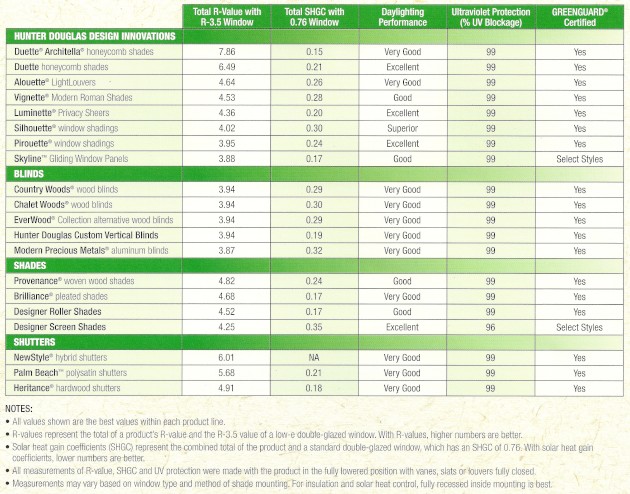| Solar Heat Gain Coeffcients (SHGC) |
The earth receives an enormous amount of solar energy from the sun. This energy is referred to as Solar Heat Gain. Solar Heat Gain is the measurement of the increase in temperature in a space, object or structure that results from this solar radiation. In the summer months when air-conditioning loads are greatest, we do not want that powerful energy entering the home to become heat. If you live in a hot climate, or anywhere summers are hot, you need window coverings that effectively reduce solar heat gain. If you live in a cold climate, you need window coverings that effectively reduce thermal heat loss (R-Value).

Three Ways to Save Energy
Installing window coverings in your home will reduce heating, cooling and lighting energy needs in three significant ways:
- Reduce Heat Flow (heat loss and heat gain) through the windows.
- Control Solar Heat Gain (heat energy from the sun) by allowing it in winter but reducing it in summer.
- Enhance Daylighting (the use of natural light) by diffusing and dispersing sunlight deep into a room reducing the need for artificial lighting.
Motorizing the window coverings and adding sensors, timers or automation control systems permit the window coverings to be opened, closed, raised or lowered at certain times of the day to compliment and enhance an energy efficient enviroment. It may be comforting to know that your home or office is as energy efficient as possible while away, at home, or on the road.
Solar Heat Gain Coefficient
Solar heat gain is measured by a coefficient from 0 to 1 that tells us what fraction of solar energy hitting the window actually enters the home. Lower numbers are better. Standard double-pane windows have a solar heat gain coefficient (SHGC) of 0.76 - meaing 76% solar heat enters into the home. Adding an insulating window covering such as a drapery or a duette shade drops the number as low as 0.15 meaning only 15% of the solar energy enters the home to become heat.
When choosing window covering products with louvers, slats or vanes, opt for white or light colors. In summer, it is important to reflect as much solar energy as possible right back out the window before it becomes heat.
Take advantage of Solar Heat Gain in Winter Months
In the winter months, when trying to reduce heating costs, take advantage of as much free heat energy from the sun as you can. This means raising or opening the window coverings whenever direct sunlight is shining.
- South Windows
Open your window treatments for the best hours of sunshine. These windows gain more heat during the daylight hours. - East and West Windows
Open the window treatments for the three to five best hours of sunshine. Solar heat is gained through east windows during morning hours and west windows in late afternoon. - North Windows
Open window treatments for sun (Daylighting) in the morning or evening to reduce lighting needs. For the most part, north facing windows receive no direct sunlight and lose more heat than they gain.
Hunter Douglas Products


The U.S. Department of Energy
Helpful Links:
Daylighting
Window Treatments
Energy Performance Ratings for Windows, Skylight, Doors







